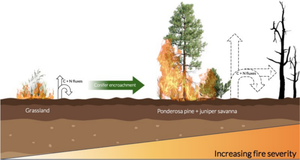Biogeochemistry ( IF 3.9 ) Pub Date : 2024-08-23 , DOI: 10.1007/s10533-024-01168-6 Justin D. Gay , Bryce Currey , Kimberley T. Davis , E. N. Jack Brookshire

|
Fire exclusion is a key factor driving conifer expansion into temperate semi-arid grasslands. However, it remains unclear how reintroducing fire affects the aboveground storage of carbon (C) and nitrogen (N) in the expanding tree species and belowground in soils. To assess the impacts of fire reintroduction C and N pools and fluxes in areas of conifer expansion we targeted a region of the Northern Great Plains that has experienced extensive woody plant expansion (WPE) of two species: ponderosa pine (Pinus ponderosa) and juniper (Juniperus spp). We quantified tree mortality of both species to estimate the amount of dead biomass C and N produced by a recent prescribed fire, in addition to changes in soil C, pyrogenic C (PyC), and N concentrations across a woody-cover gradient using a before/after/control experimental design. Post-fire soil chemical analysis revealed a 2 year increase in mineral soil C, PyC and N, suggesting the return of fire led to the transfer of partially combusted plant organic matter back to the soil. Further, we found that functional trait differences between the two species influenced the distribution of living conifer biomass-N prior to fire. Despite junipers having 41% less total aboveground biomass than ponderosa, they contained two times more aboveground N. Prescribed fire resulted in 88% mortality of all mature juniper stems and increased fire severity correlated with greater pre-fire juniper cover. Ponderosa mortality varied by size class, with > 40 cm stem diameter class having only 28% mortality. High mortality and greater aboveground N storage in juniper biomass, compared to ponderosa, led to 77% of the total conifer biomass N lost. Consequently, the functional attributes of expanding trees differentially contribute to fluxes of C and N after the return of fire, with junipers acting as conduits for N movement due to their relatively higher N content in less fire-resistant tissues and ponderosa serving as important and more stable storage pools for C. Together, these findings highlight the importance of considering species-specific traits when planning WPE management strrategies at landscape-scales, particularly when goals include C storage or soil nutrient status.
Graphical abstract
中文翻译:

针叶树扩展到温带半干旱草原的功能属性调节碳和氮通量以响应规定的火灾
防火是推动针叶树向温带半干旱草原扩张的关键因素。然而,目前尚不清楚重新引入火灾如何影响不断扩大的树种中碳(C)和氮(N)的地上储存以及土壤中的地下储存。为了评估火灾重新引入碳氮池和针叶树扩张区域通量的影响,我们以北大平原的一个地区为目标,该地区经历了两种物种的广泛木本植物扩张(WPE):黄松( Pinus ponderosa)和杜松(杜松属) 。我们量化了这两个物种的树木死亡率,以估计最近规定的火灾产生的死亡生物量 C 和 N 的量,以及使用之前的方法计算木质覆盖梯度上土壤 C、热原 C (PyC) 和 N 浓度的变化。 /之后/控制实验设计。火灾后土壤化学分析显示,土壤矿质碳、热解碳和氮在两年内增加,表明火灾的回归导致部分燃烧的植物有机物转移回土壤。此外,我们发现这两个物种之间的功能性状差异影响了火灾前活针叶树生物量-N 的分布。尽管杜松的地上总生物量比黄松少 41%,但它们的地上氮含量却高出两倍。规定的火灾导致所有成熟杜松茎的死亡率为 88%,并且火灾严重程度的增加与火灾前杜松覆盖率的增加相关。黄松死亡率因大小等级而异,茎直径 > 40 厘米等级的死亡率仅为 28%。与黄松相比,杜松生物量的高死亡率和更高的地上氮储存量导致针叶树总生物量氮损失 77%。 因此,扩张树木的功能属性对火复燃后碳和氮的通量有不同的贡献,杜松由于在耐火性较差的组织中相对较高的氮含量而充当氮移动的管道,而黄松则作为重要且更重要的氮含量。总之,这些发现强调了在规划景观尺度的 WPE 管理策略时考虑物种特定性状的重要性,特别是当目标包括碳储存或土壤养分状况时。


















































 京公网安备 11010802027423号
京公网安备 11010802027423号